A Review on Congestion Mitigation Techniques in Ultra-Dense Wireless Sensor Networks: State-of-the-Art Future Emerging Artificial Intelligence-Based Solutions
Abstract
:1. Introduction
2. Contribution of This Work
- (1)
- This survey outlines the scope of AI-based future emerging solutions for the congestion mitigation of WSNs.
- (2)
- WSN congestion mitigation solutions are divided into four major categories to support novice as well as expert readers’ understanding by means of logical segregation of the state-of-the-art literature.
- (3)
- This survey also provides criteria for integrating AI solutions into WSNs.
- (4)
- Each section is comprehensively summarized with necessary figures and tables.
- (5)
- Critical analysis of various types of AI solutions along with their applications in IoT is also an integral part of this study.
- (6)
- This study highlights future recommendations for congestion mitigation in WSNs.
Congestion
- (1)
- Throughput
- (2)
- Network Capacity
- (3)
- Efficiency
- A.
- Open Loop Congestion Mitigation
- B.
- Closed Loop Congestion Mitigation
- (1)
- Detection
- (2)
- Notification
- (3)
- Congestion Mitigation Phase
3. Why Use an Artificial Intelligence-Assisted Solution?
Why Use an ML-Based Congestion Mitigation Solution for WSNs?
4. Congestion Mitigation Algorithms for WSNs
4.1. Previous Work on WSN Congestion Mitigation Schemes
4.1.1. Conventional Algorithms for Congestion Mitigation in WSN
4.1.2. RPL-Based Algorithms for Congestion Mitigation in WSN
4.1.3. Game Theory-Based Algorithms for Congestion Mitigation in WSN
4.1.4. AI-Based Algorithms for Congestion Mitigation in WSN
- (1)
- Congestion mitigation based on RPL rare work is conducted with this type of methodology.
- (2)
- Congestion mitigation based on non-RPL methodologies did not consider the stack protocol of 6LoWPAN. One rare research work has been conducted on congestion mitigation mechanisms in RPL networks. We will explain these mechanisms in the following paragraphs.
5. Scope of AI-Based Solutions in WSNs
Significance of Proposed Work in Smart and Green World
6. Potential Future Emerging AI-Based Solutions for Congestion Mitigation in Ultra-Dense WSNs
Machine Learning (ML) for WSNs
7. Fundamentals of ML and Taxonomy of Applications
7.1. Supervised Learning
7.2. Unsupervised Learning and Semi-Supervised Learning
7.3. Reinforcement Learning
7.4. Genetic Programming
8. Learning Capabilities and Requirements
9. Artificial Neural Networks (ANNs) for Congestion Mitigation of WSNs
9.1. DL for Congestion Mitigation of Wireless-Based IoT Networks
9.1.1. Deep Neural Networks (DNNs)
9.1.2. Criteria for Application of DL Solutions in WSNs
9.1.3. Deep Transfer Learning (DTL) for WSN Congestion Mitigation
9.1.4. Deep Unfolding for Congestion Mitigation
9.1.5. Deep Learning for Cognitive Communication
10. Discussion and Significance
10.1. Game Theory
10.2. Artificial Intelligence (AI)
10.3. Machine Learning (ML)
10.4. Deep Learning (DL)
10.5. Artificial Neural Networks (ANNs) and Deep Neural Networks (DNNs)
10.6. Deep Transfer Learning
10.7. Deep Unfolding
11. Conclusions and Future Research Recommendations
- In extremely dense WSNs, dynamic wireless nodes with changing topologies and placements predominate. The development of congestion mitigation algorithms must take this dynamic nature into account. These network requirements should be addressed through efficient congestion mitigation techniques.
- Numerous wireless sensor nodes with different capabilities, data requirements, and communication protocols form extremely dense wireless IoT sensor networks. Managing traffic congestion in a highly complex environment is a challenging topic for scientists and is, therefore, a well-known research area.
- There are often constraints on the power, memory, and bandwidth of wireless nodes. These limitations must be prioritized in newly developed congestion mitigation methods used in IoT.
- IoT devices that process sensitive data are found in highly populated WSNs. These devices face security and privacy threats due to congestion. In addition, these devices need to collect sensitive and personal information in order to use new approaches for congestion mitigation. When using congestion mitigation approaches, it becomes increasingly important to ensure the security and privacy of IoT-sensitive data. In this situation, the distributed learning approach known as federated learning can protect sensitive data.
- WSNs must be able to process data and make decisions for many IoT devices in real time. Giving these high-priority devices an immediate reprieve requires innovative approaches to eliminate congestion. Striking a balance between reducing latency and successfully managing congestion is a difficult task. Congestion reduction in WSNs presents a great opportunity for hybrid AI algorithms that combine established conventional and AI-based emergent algorithms. Combining two or more AI techniques, such as prediction and learning or optimization and learning, leads to a variety of hybrid algorithms. This area should be further explored [129,130].
Author Contributions
Funding
Institutional Review Board Statement
Informed Consent Statement
Acknowledgments
Conflicts of Interest
References
- Statista―Number-of-Mobile-Devices-Worldwide-2021–2030. Available online: https://www.statista.com/statistics/245501/multiple-mobiledeviceownership-worldwide (accessed on 1 July 2023).
- Yang, B.; Zhang, H.; Du, M.; Wang, A.; Xiong, K. Urban traffic congestion alleviation system based on millimeter wave radar and improved probabilistic neural network. IET Radar. Sonar Navig. 2023. [Google Scholar] [CrossRef]
- Singh, S.; Singh, J.; Goyal, S.; Sehra, S.S.; Ali, F.; Alkhafaji, M.A.; Singh, R. A novel framework to avoid traffic congestion and air pollution for sustainable development of smart cities. Sustain. Energy Technol. Assess. 2023, 56. [Google Scholar] [CrossRef]
- He, Z.; Chen, L.; Li, F.; Jin, G. Congestion Avoidance in Intelligent Transport Networks Based on WSN-IoT through Controlling Data Rate of Zigbee Protocol by Learning Automata. Electronics 2023, 12, 2070. [Google Scholar] [CrossRef]
- Sharma, S.K.; Wang, X. Distributed Caching Enabled Peak Traffic Reduction in Ultra-Dense IoT Networks. IEEE Commun. Lett. 2018, 22, 1252–1255. [Google Scholar] [CrossRef]
- Nowbahari, A. Low Power Circuits and Architectures for Wireless Sensor Networks. Ph.D. Thesis, University of South-Eastern Norway, Notodden, Norway, 2023. [Google Scholar]
- Varasano, A.; Fraddosio, A.; Piccioni, M.D.; Andria, G. Development and Characterization of an IoT Cloud Platform Operating in 5G Network for Structural Health Monitoring of Civil Constructions. In Proceedings of the 2023 IEEE International Workshop on Metrology for Living Environment (MetroLivEnv), Milano, Italy, 29–31 May 2023; IEEE: Piscataway, NJ, USA, 2023; pp. 269–275. [Google Scholar]
- Umar, A.; Ullah, R.; Safdar, Z.K.H. Non-Orthogonal Multiple Access for Future Emerging Ad-Hoc Networks. IJCSNS Int. J. Comput. Sci. Netw. Secur. 2022, 22, 788. [Google Scholar]
- Schindelhauer, C. Mobility in wireless networks. In International Conference on Current Trends in Theory and Practice of Computer Science; Springer: Berlin/Heidelberg, Germany, 2006; pp. 100–116. [Google Scholar]
- Shanthamallu, U.S.; Spanias, A.; Tepedelenlioglu, C.; Stanley, M. A brief survey of machine learning methods and their sensor and IoT applications. In Proceedings of the 2017 8th International Conference on Information, Intelligence, Systems & Applications (IISA), Larnaca, Cyprus, 27–30 August 2017; pp. 1–8. [Google Scholar]
- Jouhari, M.; Saeed, N.; Alouini, M.-S.; Amhoud, E.M. A Survey on Scalable LoRaWAN for Massive IoT: Recent Advances, Potentials, and Challenges. IEEE Commun. Surv. Tutor. 2023, 25, 1841–1876. [Google Scholar] [CrossRef]
- Akyildiz, I.F.; Vuran, M.C. Wireless Sensor Networks; John Wiley & Sons: Hoboken, NJ, USA, 2010. [Google Scholar]
- Khalid, Z.; Fisal, N.; Rozaini, M. A Survey of Middleware for Sensor and Network Virtualization. Sensors 2014, 14, 24046–24097. [Google Scholar] [CrossRef] [PubMed]
- Prasad, P. Recent trend in wireless sensor network and its applications: A survey. Sens. Rev. 2015, 35, 229–236. [Google Scholar] [CrossRef]
- Bandyopadhyay, D.; Sen, J. Internet of Things: Applications and Challenges in Technology and Standardization. Wirel. Pers. Commun. 2011, 58, 49–69. [Google Scholar] [CrossRef]
- Antoniou, P.; Pitsillides, A.; Blackwell, T.; Engelbrecht, A.; Michael, L. Congestion control in wireless sensor networks based on bird flocking behavior. Comput. Networks 2013, 57, 1167–1191. [Google Scholar] [CrossRef]
- Bohloulzadeh, A.; Rajaei, M. A Survey on Congestion Control Protocols in Wireless Sensor Networks. Int. J. Wirel. Inf. Networks 2020, 27, 365–384. [Google Scholar] [CrossRef]
- Chen, T.-S.; Kuo, C.-H.; Wu, Z.-X. Adaptive Load-Aware Congestion Control Protocol for Wireless Sensor Networks. Wirel. Pers. Commun. 2017, 97, 3483–3502. [Google Scholar] [CrossRef]
- Ghaffari, A. Congestion control mechanisms in wireless sensor networks: A survey. J. Netw. Comput. Appl. 2015, 52, 101–115. [Google Scholar] [CrossRef]
- Wan, C.-Y.; Eisenman, S.B.; Campbell, A.T. Energy-efficient congestion detection and avoidance in sensor networks. ACM Trans. Sens. Networks 2011, 7, 1–31. [Google Scholar] [CrossRef]
- Farhadi, G.; Ito, A. Group-based signaling and access control for cellular machine-to-machine communication. In Proceedings of the 2013 IEEE 78th Vehicular Technology Conference (VTC Fall), Las Vegas, NV, USA, 2–5 September 2013; pp. 1–6. [Google Scholar]
- Janbi, N.; Katib, I.; Albeshri, A.; Mehmood, R. Distributed Artificial Intelligence-as-a-Service (DAIaaS) for Smarter IoE and 6G Environments. Sensors 2020, 20, 5796. [Google Scholar] [CrossRef]
- Shobana, M.; Poonkuzhali, S. A novel approach to detect IoT malware by system calls using Deep learning techniques. In Proceedings of the 2020 International Conference on Innovative Trends in Information Technology (ICITIIT), Kottayam, India, 13–14 February 2020; pp. 1–5. [Google Scholar]
- Hussain, F.; Hassan, S.A.; Hussain, R.; Hossain, E. Machine Learning for Resource Management in Cellular and IoT Networks: Potentials, Current Solutions, and Open Challenges. IEEE Commun. Surv. Tutorials 2020, 22, 1251–1275. [Google Scholar] [CrossRef]
- Yao, S.; Zhao, Y.; Zhang, A.; Hu, S.; Shao, H.; Zhang, C.; Su, L.; Abdelzaher, T. Deep learning for the internet of things. Computer 2018, 51, 32–41. [Google Scholar] [CrossRef]
- Machado, R.; Tekinay, S. A survey of game-theoretic approaches in wireless sensor networks. Comput. Networks 2008, 52, 3047–3061. [Google Scholar] [CrossRef]
- Elsaadany, M.; Ali, A.; Hamouda, W. Cellular LTE-A Technologies for the Future Internet-of-Things: Physical Layer Features and Challenges. IEEE Commun. Surv. Tutorials 2017, 19, 2544–2572. [Google Scholar] [CrossRef]
- Bin Zikria, Y.; Afzal, M.K.; Ishmanov, F.; Kim, S.W.; Yu, H. A survey on routing protocols supported by the Contiki Internet of things operating system. Futur. Gener. Comput. Syst. 2018, 82, 200–219. [Google Scholar] [CrossRef]
- Tan, C.; Sun, F.; Kong, T.; Zhang, W.; Yang, C.; Liu, C. A survey on deep transfer learning. In Proceedings of the 27th International Conference on Artificial Neural Networks, Rhodes, Greece, 4–7 October 2018; pp. 270–279. [Google Scholar]
- Luong, N.C.; Hoang, D.T.; Gong, S.; Niyato, D.; Wang, P.; Liang, Y.-C.; Kim, D.I. Applications of Deep Reinforcement Learning in Communications and Networking: A Survey. IEEE Commun. Surv. Tutor. 2019, 21, 3133–3174. [Google Scholar] [CrossRef]
- Mahajan, M.; Kaur, S. Congestion Control Protocols in Wireless Sensor Networks: A comprehensive Survey. In Proceedings of the 2020 International Conference on Intelligent Engineering and Management (ICIEM), London, UK, 17–19 June 2020; pp. 160–164. [Google Scholar]
- Pan, S.J.; Yang, Q. A Survey on Transfer Learning. IEEE Trans. Knowl. Data Eng. 2010, 22, 1345–1359. [Google Scholar] [CrossRef]
- Gautam, A.; Ibraheem; Sharma, G.; Ahmer, M.F.; Krishnan, N. Methods and Methodologies for Congestion Alleviation in the DPS: A Comprehensive Review. Energies 2023, 16, 1765. [Google Scholar] [CrossRef]
- El Tanab, M.; Hamouda, W. Machine-to-Machine Communications With Massive Access: Congestion Control. IEEE Internet Things J. 2018, 6, 3545–3557. [Google Scholar] [CrossRef]
- Rukaiya, R.; Farooq, M.U.; Khan, S.A.; Hussain, F.; Akhunzada, A. CFFD-MAC: A Hybrid MAC for Collision Free Full-Duplex Communication in Wireless Ad-Hoc Networks. IEEE Access 2021, 9, 35584–35598. [Google Scholar] [CrossRef]
- Wu, H.; Member, S.; Zhu, C.; La, R.J. FASA: Accelerated S-ALOHA Using Access History for Event-Driven M2M Com-munications. IEEE/ACM Trans. Netw. 2013, 21, 1904–1917. [Google Scholar] [CrossRef]
- Wu, T.; Zhou, P.; Wang, B.; Li, A.; Tang, X.; Xu, Z.; Chen, K.; Ding, X. Joint traffic control and multi-channel reassignment for core backbone network in SDN-IoT: A multi-agent deep reinforcement learning approach. IEEE Trans. Netw. Sci. Eng. 2020, 8, 231–245. [Google Scholar] [CrossRef]
- Ali, S.; Hossain, E.; Kim, D.I. LTE/LTE-A Random Access for Massive Machine-Type Communications in Smart Cities. IEEE Commun. Mag. 2017, 55, 76–83. [Google Scholar] [CrossRef]
- Cheng, R.-G.; Chen, J.; Chen, D.-W.; Wei, C.-H. Modeling and Analysis of an Extended Access Barring Algorithm for Machine-Type Communications in LTE-A Networks. IEEE Trans. Wirel. Commun. 2015, 14, 2956–2968. [Google Scholar] [CrossRef]
- Ndikumana, A.; Ullah, S.; Thar, K.; Tran, N.H.; Park, B.J.; Hong, C.S. Novel Cooperative and Fully-Distributed Congestion Control Mechanism for Content Centric Networking. IEEE Access 2017, 5, 27691–27706. [Google Scholar] [CrossRef]
- Al-Kashoash, H.A.A.; Hafeez, M.; Kemp, A.H. Congestion control for 6LoWPAN networks: A game theoretic framework. IEEE Internet Things J. 2017, 4, 760–771. [Google Scholar] [CrossRef]
- Tang, W.; Ma, X.; Huang, J.; Wei, J. Toward Improved RPL: A Congestion Avoidance Multipath Routing Protocol with Time Factor for Wireless Sensor Networks. J. Sensors 2015, 2016, 8128651. [Google Scholar] [CrossRef]
- Leon, J.P.A.; Rico-Novella, F.J.; Llopis, L.J.D.L.C. Predictive Traffic Control and Differentiation on Smart Grid Neighborhood Area Networks. IEEE Access 2020, 8, 216805–216821. [Google Scholar] [CrossRef]
- Ma, C.; Sheu, J.-P.; Hsu, C.-X. A Game Theory Based Congestion Control Protocol for Wireless Personal Area Networks. J. Sensors 2015, 2016, 6168535. [Google Scholar] [CrossRef]
- Elappila, M.; Chinara, S.; Parhi, D.R. Survivable Path Routing in WSN for IoT applications. Pervasive Mob. Comput. 2018, 43, 49–63. [Google Scholar] [CrossRef]
- Chanak, P.; Banerjee, I. Congestion free routing mechanism for IoT-enabled wireless sensor networks for smart healthcare applications. IEEE Trans. Consum. Electron. 2020, 66, 223–232. [Google Scholar] [CrossRef]
- Sergiou, C.; Vassiliou, V.; Paphitis, A. Hierarchical Tree Alternative Path (HTAP) algorithm for congestion control in wireless sensor networks. Ad Hoc Networks 2013, 11, 257–272. [Google Scholar] [CrossRef]
- Zabin, F.; Misra, S.; Woungang, I.; Rashvand, H.; Ma, N.-W.; Ali, M.A. REEP: Data-centric, energy-efficient and reliable routing protocol for wireless sensor networks. IET Commun. 2008, 2, 995–1008. [Google Scholar] [CrossRef]
- Sergiou, C.; Vassiliou, V.; Paphitis, A. Congestion control in Wireless Sensor Networks through dynamic alternative path selection. Comput. Networks 2014, 75, 226–238. [Google Scholar] [CrossRef]
- Kang, J.; Zhang, Y.; Nath, B. TARA: Topology-Aware Resource Adaptation to Alleviate Congestion in Sensor Networks. IEEE Trans. Parallel Distrib. Syst. 2007, 18, 919–931. [Google Scholar] [CrossRef]
- Guo, J.; Wen, C.-K.; Jin, S.; Li, G.Y. Convolutional neural network-based multiple-rate compressive sensing for massive MIMO CSI feedback: Design, simulation, and analysis. IEEE Trans. Wirel. Commun. 2020, 19, 2827–2840. [Google Scholar] [CrossRef]
- Farsi, M.; Badawy, M.; Moustafa, M.; Arafat, H.A.; Abdulazeem, Y. A Congestion-Aware Clustering and Routing (CCR) Protocol for Mitigating Congestion in WSN. IEEE Access 2019, 7, 105402–105419. [Google Scholar] [CrossRef]
- Mukherjee, A.; Goswami, P.; Yang, L.; Tyagi, S.K.S.; Samal, U.C.; Mohapatra, S.K. Deep neural network-based clustering technique for secure IIoT. Neural Comput. Appl. 2020, 32, 16109–16117. [Google Scholar] [CrossRef]
- Al-Jamali, N.A.S.; Al-Raweshidy, H.S. Smart IoT network based convolutional recurrent neural network with element-wise prediction system. IEEE Access 2021, 9, 47864–47874. [Google Scholar] [CrossRef]
- Sharma, S.K.; Wang, X. Collaborative Distributed Q-Learning for RACH Congestion Minimization in Cellular IoT Networks. IEEE Commun. Lett. 2019, 23, 600–603. [Google Scholar] [CrossRef]
- Jung, S.Y.; Lee, S.H.; Kim, J.-H. Reliability Control Framework for Random Access of Massive IoT Devices. IEEE Access 2019, 7, 49928–49937. [Google Scholar] [CrossRef]
- Hassan, R.; Jubair, A.M.; Azmi, K.; Bakar, A. Adaptive congestion control mechanism in CoAP application protocol for internet of things (IoT). In Proceedings of the 2016 International Conference on Signal Processing and Communication (ICSC), Noida, India, 26–28 December 2016; pp. 121–125. [Google Scholar]
- Sharma, B.; Srivastava, G.; Lin, J.C.-W. A bidirectional congestion control transport protocol for the internet of drones. Comput. Commun. 2020, 153, 102–116. [Google Scholar] [CrossRef]
- Zhuang, Y.; Yu, L.; Shen, H.; Kolodzey, W.; Iri, N.; Caulfield, G.; He, S. Data Collection with Accuracy-Aware Congestion Control in Sensor Networks. IEEE Trans. Mob. Comput. 2018, 18, 1068–1082. [Google Scholar] [CrossRef]
- Kamimura, A.; Tomita, K. A self-organizing network coordination framework enabling collision-free and congestion-less wireless sensor networks. J. Netw. Comput. Appl. 2017, 93, 228–244. [Google Scholar] [CrossRef]
- Khalil, N.; Abid, M.R.; Benhaddou, D.; Gerndt, M. Wireless sensors networks for Internet of Things. In Proceedings of the 2014 IEEE Ninth International Conference on Intelligent Sensors, Sensor Networks and Information Processing (ISSNIP), Singapore, 21–24 April 2014; pp. 1–6. [Google Scholar]
- Kushalnagar, N.; Montenegro, G.; Schumacher, C. IPv6 over Low-Power Wireless Personal Area Networks (6LoWPANs): Overview, Assumptions, Problem Statement, and Goals. 2007. Available online: https://www.rfc-editor.org/rfc/rfc4919 (accessed on 21 July 2023).
- Sunitha, G.P.; Kumar, S.M.D.; Kumar, B.P.V. Energy Balanced Zone Based Routing Protocol to Mitigate Congestion in Wireless Sensor Networks. Wirel. Pers. Commun. 2017, 97, 2683–2711. [Google Scholar] [CrossRef]
- Al-Kashoash, H.A.A.; Al-Nidawi, Y.; Kemp, A.H. Congestion-aware RPL for 6L0WPAN networks. In Proceedings of the 2016 Wireless Telecommunications Symposium (WTS), London, UK, 18–20 April 2016; pp. 1–6. [Google Scholar]
- Winter, T.; Thubert, P.; Brandt, A.; Hui, J.; Kelsey, R.; Levis, P.; Alexander, R. RPL: IPv6 Routing Protocol for Low-Power and Lossy Networks. 2012. Available online: https://www.rfc-editor.org/rfc/pdfrfc/rfc6550.txt.pdf (accessed on 1 July 2023).
- Bouaziz, M.; Rachedi, A.; Belghith, A.; Berbineau, M.; Al-Ahmadi, S. EMA-RPL: Energy and mobility aware routing for the Internet of Mobile Things. Futur. Gener. Comput. Syst. 2019, 97, 247–258. [Google Scholar] [CrossRef]
- Fotouhi, H.; Moreira, D.; Alves, M. mRPL: Boosting mobility in the Internet of Things. Ad Hoc Networks 2015, 26, 17–35. [Google Scholar] [CrossRef]
- Kim, H.-S.; Cho, H.; Kim, H.; Bahk, S. DT-RPL: Diverse bidirectional traffic delivery through RPL routing protocol in low power and lossy networks. Comput. Networks 2017, 126, 150–161. [Google Scholar] [CrossRef]
- Al-Kashoash, H.A.A.; Amer, H.M.; Mihaylova, L.; Kemp, A.H. Optimization Based Hybrid Congestion Alleviation for 6LoWPAN Networks. IEEE Internet Things J. 2017, 4, 2070–2081. [Google Scholar] [CrossRef]
- Castellani, A.P.; Rossi, M.; Zorzi, M. Back pressure congestion control for CoAP/6LoWPAN networks. Ad Hoc Networks 2014, 18, 71–84. [Google Scholar] [CrossRef]
- Contiki OS and Cooja Simulator. Available online: http://www.contiki-os.org/ (accessed on 22 April 2019).
- Chowdhury, S.; Giri, C. Non-cooperative game theory based congestion control in lossy WSN. In Proceedings of the 2018 IEEE Global Communications Conference (GLOBECOM), Abu Dhabi, United Arab Emirates, 9–13 December 2018; pp. 1–7. [Google Scholar]
- Hellaoui, H.; Koudil, M. Bird flocking congestion control for CoAP/RPL/6LoWPAN networks. In Proceedings of the 2015 Workshop on IoT Challenges in Mobile and Industrial Systems, Florence, Italy, 18 May 2015; pp. 25–30. [Google Scholar]
- Kim, H.-S.; Paek, J.; Bahk, S. QU-RPL: Queue utilization based RPL for load balancing in large scale industrial applications. In Proceedings of the 2015 12th Annual IEEE International Conference on Sensing, Communication, and Networking (SECON), Seattle, WA, USA, 22–25 June 2015; pp. 265–273. [Google Scholar]
- Shi, H.-Y.; Wang, W.-L.; Kwok, N.-M.; Chen, S.-Y. Game Theory for Wireless Sensor Networks: A Survey. Sensors 2012, 12, 9055–9097. [Google Scholar] [CrossRef]
- Han, Z.; Niyato, D.; Saad, W.; Başar, T.; Hjørungnes, A. Game Theory in Wireless and Communication Networks: Theory, Models, and Applications; Cambridge University Press: Cambridge, UK, 2012. [Google Scholar]
- Sun, W.; Liu, J. Coordinated Multipoint-Based Uplink Transmission in Internet of Things Powered by Energy Harvesting. IEEE Internet Things J. 2017, 5, 2585–2595. [Google Scholar] [CrossRef]
- Chi, K.; Chen, Z.; Zheng, K.; Zhu, Y.-H.; Liu, J. Energy Provision Minimization in Wireless Powered Communication Networks With Network Throughput Demand: TDMA or NOMA? IEEE Trans. Commun. 2019, 67, 6401–6414. [Google Scholar] [CrossRef]
- Chowdhury, S.; Benslimane, A.; Giri, C. Noncooperative Gaming for Energy-Efficient Congestion Control in 6LoWPAN. IEEE Internet Things J. 2020, 7, 4777–4788. [Google Scholar] [CrossRef]
- Naeem, F.; Srivastava, G.; Tariq, M. A software defined network based fuzzy normalized neural adaptive multipath congestion control for the internet of things. IEEE Trans. Netw. Sci. Eng. 2020, 7, 2155–2164. [Google Scholar] [CrossRef]
- Jiang, N.; Deng, Y.; Nallanathan, A.; Yuan, J. A Decoupled Learning Strategy for Massive Access Optimization in Cellular IoT Networks. IEEE J. Sel. Areas Commun. 2020, 39, 668–685. [Google Scholar] [CrossRef]
- Pratas, N.K.; Thomsen, H.; Stefanović, Č.; Popovski, P. Code-expanded random access for machine-type communications. In Proceedings of the 2012 IEEE Globecom Workshops, Anaheim, CA, USA, 3–7 December 2012; pp. 1681–1686. [Google Scholar]
- Shreyas, J.; Singh, H.; Bhutani, J.; Pandit, S.; Srinidhi, N.N.; SM, D.K. Congestion aware algorithm using fuzzy logic to find an optimal routing path for IoT networks. In Proceedings of the 2019 International conference on computational intelligence and knowledge economy (ICCIKE), Dubai, United Arab Emirates, 11–12 December 2019; pp. 141–145. [Google Scholar]
- Yin, X.; Zhou, X.; Huang, R.; Fang, Y.; Li, S. A Fairness-Aware Congestion Control Scheme in Wireless Sensor Networks. IEEE Trans. Veh. Technol. 2009, 58, 5225–5234. [Google Scholar] [CrossRef]
- Alcaraz, C.; Najera, P.; Lopez, J.; Roman, R. Wireless sensor networks and the internet of things: Do we need a complete integration? In Proceedings of the 1st International Workshop on the Security of the Internet of Things (SecIoT’10); IEEE: Piscataway, NJ, USA, 2010. [Google Scholar]
- Singh, K.; Singh, K.; Son, L.H.; Aziz, A. Congestion control in wireless sensor networks by hybrid multi-objective optimization algorithm. Comput. Netw. 2018, 138, 90–107. [Google Scholar] [CrossRef]
- Shelke, M.P.; Malhotra, A.; Mahalle, P. A packet priority intimation-based data transmission for congestion free traffic management in wireless sensor networks. Comput. Electr. Eng. 2017, 64, 248–261. [Google Scholar] [CrossRef]
- Godoy, P.D.; Cayssials, R.L.; Garino, C.G.G. Communication channel occupation and congestion in wireless sensor networks. Comput. Electr. Eng. 2018, 72, 846–858. [Google Scholar] [CrossRef]
- Bibri, S.E.; Alexandre, A.; Sharifi, A.; Krogstie, J. Environmentally sustainable smart cities and their converging AI, IoT, and big data technologies and solutions: An integrated approach to an extensive literature review. Energy Inform. 2023, 6, 9. [Google Scholar] [CrossRef] [PubMed]
- Doyu, H.; Morabito, R.; Brachmann, M. A tinymlaas ecosystem for machine learning in iot: Overview and research challenges. In Proceedings of the 2021 International Symposium on VLSI Design, Automation and Test (VLSI-DAT), Hsinchu, Taiwan, 19–22 April 2021; pp. 1–5. [Google Scholar]
- Michopoulos, V.; Guan, L.; Oikonomou, G.; Phillips, I. DCCC6: Duty Cycle-aware congestion control for 6LoWPAN networks. In Proceedings of the 2012 IEEE International Conference on Pervasive Computing and Communications Workshops, Lugano, Switzerland, 19–23 March 2012; pp. 278–283. [Google Scholar]
- Veeragandham, S.; Santhi, H. Role of IoT, image processing and machine learning techniques in weed detection: A review. Int. J. Internet Technol. Secur. Trans. 2022, 12, 185. [Google Scholar] [CrossRef]
- Hojabri, M.; Kellerhals, S.; Upadhyay, G.; Bowler, B. IoT-Based PV Array Fault Detection and Classification Using Embedded Supervised Learning Methods. Energies 2022, 15, 2097. [Google Scholar] [CrossRef]
- Djenouri, Y.; Belhadi, A.; Srivastava, G.; Lin, J.C.-W. When explainable AI meets IoT applications for supervised learning. Clust. Comput. 2022, 26, 2313–2323. [Google Scholar] [CrossRef]
- Ma, X.; Ye, H.; Li, Y. Learning assisted estimation for time-varying channel. In Proceedings of the 2018 15th International Symposium on Wireless Communication Systems (ISWCS), Lisbon, Portugal, 28–31 August 2018; pp. 1–5. [Google Scholar]
- Nawaz, S.J.; Khan, N.M.; Tiwana, M.I.; Hassan, N.; Shah, S.I. Airborne internet access through submarine optical fiber cables. IEEE Trans. Aerosp. Electron. Syst. 2015, 51, 167–177. [Google Scholar] [CrossRef]
- Nguyen, H.N.; Tran, N.N.; Hoang, T.H.; Cao, V.L. Denoising Latent Representation with SOMs for Unsupervised IoT Malware Detection. SN Comput. Sci. 2022, 3, 474. [Google Scholar] [CrossRef]
- Idrissi, I.; Azizi, M.; Moussaoui, O. An unsupervised generative adversarial network based-host intrusion detection system for internet of things devices. Indones. J. Electr. Eng. Comput. Sci. 2022, 25, 1140–1150. [Google Scholar] [CrossRef]
- Dong, G.; Tang, M.; Wang, Z.; Gao, J.; Guo, S.; Cai, L.; Gutierrez, R.; Campbell, B.; Barnes, L.E.; Boukhechba, M. Graph Neural Networks in IoT: A Survey. ACM Trans. Sens. Networks 2023, 19, 1–50. [Google Scholar] [CrossRef]
- Tanwar, S.; Garg, J.; Gupta, M.; Rana, A. Opportunities and Challenges in Machine Learning with IoT. In Machine Learning Paradigm for Internet of Things Applications; Wiley: Hoboken, NJ, USA, 2022; pp. 209–227. [Google Scholar]
- Elhammouti, H.; Sabir, E.; Benjillali, M.; Echabbi, L.; Tembine, H. Self-Organized Connected Objects: Rethinking QoS Provisioning for IoT Services. IEEE Commun. Mag. 2017, 55, 41–47. [Google Scholar] [CrossRef]
- Li, R.; Zhao, Z.; Zhou, X.; Ding, G.; Chen, Y.; Wang, Z.; Zhang, H. Intelligent 5G: When Cellular Networks Meet Artificial Intelligence. IEEE Wirel. Commun. 2017, 24, 175–183. [Google Scholar] [CrossRef]
- Alatabani, L.E.; Ali, E.S.; Mokhtar, R.A.; Saeed, R.A.; Alhumyani, H.; Hasan, M.K. Deep and Reinforcement Learning Technologies on Internet of Vehicle (IoV) Applications: Current Issues and Future Trends. J. Adv. Transp. 2022, 2022, 1947886. [Google Scholar] [CrossRef]
- Li, T.; Zhu, K.; Luong, N.C.; Niyato, D.; Wu, Q.; Zhang, Y.; Chen, B. Applications of Multi-Agent Reinforcement Learning in Future Internet: A Comprehensive Survey. IEEE Commun. Surv. Tutorials 2022, 24, 1240–1279. [Google Scholar] [CrossRef]
- Tanveer, J.; Haider, A.; Ali, R.; Kim, A. An Overview of Reinforcement Learning Algorithms for Handover Management in 5G Ultra-Dense Small Cell Networks. Appl. Sci. 2022, 12, 426. [Google Scholar] [CrossRef]
- Nasir, Y.S.; Guo, D. Multi-Agent Deep Reinforcement Learning for Dynamic Power Allocation in Wireless Networks. IEEE J. Sel. Areas Commun. 2019, 37, 2239–2250. [Google Scholar] [CrossRef]
- Bello, L.M.; Mitchell, P.D.; Grace, D. Intelligent RACH Access Techniques to Support M2M Traffic in Cellular Networks. IEEE Trans. Veh. Technol. 2018, 67, 8905–8918. [Google Scholar] [CrossRef]
- Azar, M.G.; Munos, R.; Ghavamzadaeh, M.; Kappen, H.J. Speedy Q-learning. In Proceedings of the 24th Advances in Neural Information Processing Systems, Granada, Spain, 12–15 December 2011. [Google Scholar]
- Liu, Y.; Bi, S.; Shi, Z.; Hanzo, L. When Machine Learning Meets Big Data: A Wireless Communication Perspective. IEEE Veh. Technol. Mag. 2019, 15, 63–72. [Google Scholar] [CrossRef]
- Agrawal, A.; Pandey, S.N.; Srivastava, L.; Walde, P.; Singh, S.; Khan, B.; Saket, R.K. Hybrid Deep Neural Network-Based Generation Rescheduling for Congestion Mitigation in Spot Power Market. IEEE Access 2022, 10, 29267–29276. [Google Scholar] [CrossRef]
- Khan, A.R.; Kashif, M.; Jhaveri, R.H.; Raut, R.; Saba, T.; Bahaj, S.A. Deep learning for intrusion detection and security of Internet of things (IoT): Current analysis, challenges, and possible solutions. Secur. Commun. Netw. 2022, 2022, 4016073. [Google Scholar] [CrossRef]
- Farhan, B.I.; D. Jasim, A. A Survey of Intrusion Detection Using Deep Learning in Internet of Things. Iraqi J. Comput. Sci. Math. 2022, 3, 83–93. [Google Scholar] [CrossRef]
- Shadroo, S.; Rahmani, A.M.; Rezaee, A. Survey on the application of deep learning in the Internet of Things. Telecommun. Syst. 2022, 79, 601–627. [Google Scholar] [CrossRef]
- Zappone, A.; Di Renzo, M.; Debbah, M. Wireless networks design in the era of deep learning: Model-based, AI-based, or both? IEEE Trans. Commun. 2019, 67, 7331–7376. [Google Scholar] [CrossRef]
- Yempally, S.; Singh, S.K.; Velliangiri, S. Analytical review on deep learning and IoT for smart healthcare monitoring system. Int. J. Intell. Unmanned Syst. 2022. ahead-of-print. [Google Scholar] [CrossRef]
- Bhattacharya, S.; Somayaji, S.R.K.; Gadekallu, T.R.; Alazab, M.; Maddikunta, P.K.R. A review on deep learning for future smart cities. Internet Technol. Lett. 2020, 5, e187. [Google Scholar] [CrossRef]
- Xia, W.; Zheng, G.; Zhu, Y.; Zhang, J.; Wang, J.; Petropulu, A.P. A Deep Learning Framework for Optimization of MISO Downlink Beamforming. IEEE Trans. Commun. 2019, 68, 1866–1880. [Google Scholar] [CrossRef]
- Olayode, I.O.; Severino, A.; Campisi, T.; Tartibu, L.K. Prediction of Vehicular Traffic Flow Using Levenberg-Marquardt Artificial Neural Network Model: Italy Road Transportation System. Commun.—Sci. Lett. Univ. Zilina 2022, 24, E74–E86. [Google Scholar] [CrossRef]
- Navabi, S.; Wang, C.; Bursalioglu, O.Y.; Papadopoulos, H. Predicting wireless channel features using neural networks. In Proceedings of the 2018 IEEE International Conference on Communications (ICC), Kansas City, MO, USA, 20–24 May 2018; pp. 1–6. [Google Scholar]
- Lakhan, A.; Mastoi, Q.-U.; Elhoseny, M.; Memon, M.S.; Mohammed, M.A. Deep neural network-based application partitioning and scheduling for hospitals and medical enterprises using IoT assisted mobile fog cloud. Enterp. Inf. Syst. 2021, 16. [Google Scholar] [CrossRef]
- Wu, B.-Y.; Lu, C.-H. Pure Frequency-Domain Deep Neural Network for IoT-enabled Smart Cameras. IEEE Internet Things J. 2022, 9, 19049–19061. [Google Scholar] [CrossRef]
- Zappone, A.; Debbah, M.; Altman, Z. Online energy-efficient power control in wireless networks by deep neural networks. In Proceedings of the 2018 IEEE 19th International Workshop on Signal Processing Advances in Wireless Communications (SPAWC), Kalamata, Greece, 25–28 June 2018; pp. 1–5. [Google Scholar]
- Hershey, J.R.; Le Roux, J.; Weninger, F. Deep unfolding: Model-based inspiration of novel deep architectures. arXiv 2014, arXiv:1409.2574. [Google Scholar]
- Rondeau, T.W.; Le, B.; Rieser, C.J.; Bostian, C.W. Cognitive Radios with Genetic Algorithms: Intelligent Control of Software Defined Radios. In Proceedings of the SDR Forum Technical Conference. 2004, Volume 100, pp. 3–8. Available online: https://www.wirelessinnovation.org/assets/Proceedings/2004/2004-sdr04-1-5-1ppt-rondeau-presentation.pdf (accessed on 1 July 2023).
- Akyildiz, I.F.; Lee, W.-Y.; Vuran, M.C.; Mohanty, S. NeXt generation/dynamic spectrum access/cognitive radio wireless networks: A survey. Comput. Netw. 2006, 50, 2127–2159. [Google Scholar] [CrossRef]
- Sharma, S.K.; Bogale, T.E.; Chatzinotas, S.; Ottersten, B.; Le, L.B.; Wang, X. Cognitive Radio Techniques Under Practical Imperfections: A Survey. IEEE Commun. Surv. Tutorials 2015, 17, 1858–1884. [Google Scholar] [CrossRef]
- Thilina, K.M.; Choi, K.W.; Saquib, N.; Hossain, E. Machine learning techniques for cooperative spectrum sensing in cognitive radio networks. IEEE J. Sel. Areas Commun. 2013, 31, 2209–2221. [Google Scholar] [CrossRef]
- Li, X.; Fang, J.; Cheng, W.; Duan, H.; Chen, Z.; Li, H. Intelligent Power Control for Spectrum Sharing in Cognitive Radios: A Deep Reinforcement Learning Approach. IEEE Access 2018, 6, 25463–25473. [Google Scholar] [CrossRef]
- Bhaskar, K.V.; Kumanan, T.; Southry, S.S.; Elangovan, V. Deep Neural Network Algorithm to Improve Link Reliability in Wireless Sensor Networks. In Proceedings of the 2023 4th International Conference on Electronics and Sustainable Communication Systems (ICESC), Coimbatore, India, 6–8 July 2023; IEEE: Piscataway, NJ, USA, 2023; pp. 476–480. [Google Scholar]
- Donta, P.K.; Srirama, S.N.; Amgoth, T.; Annavarapu, C.S.R. iCoCoA: Intelligent congestion control algorithm for CoAP using deep reinforcement learning. J. Ambient. Intell. Humaniz. Comput. 2023, 14, 2951–2966. [Google Scholar] [CrossRef]
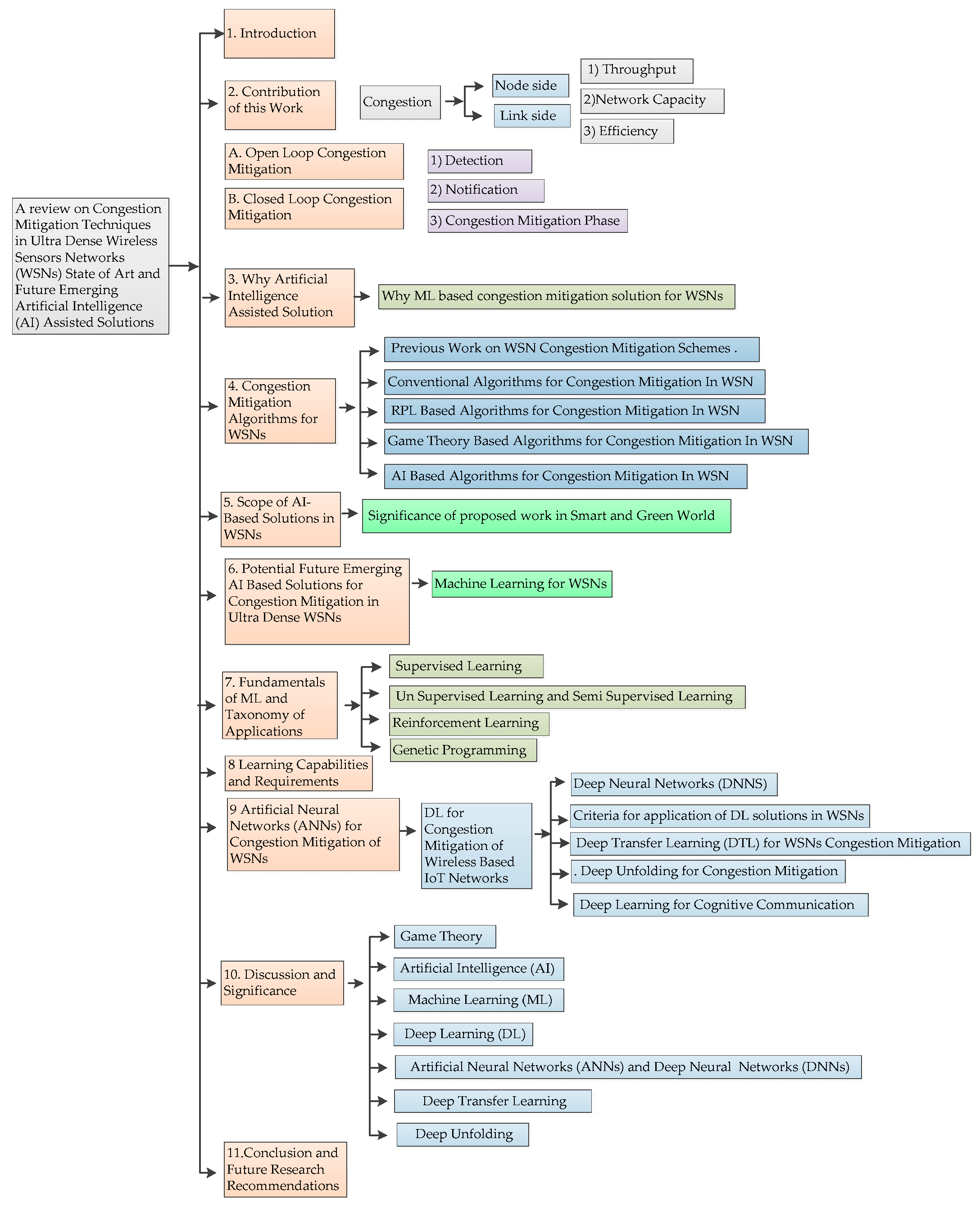
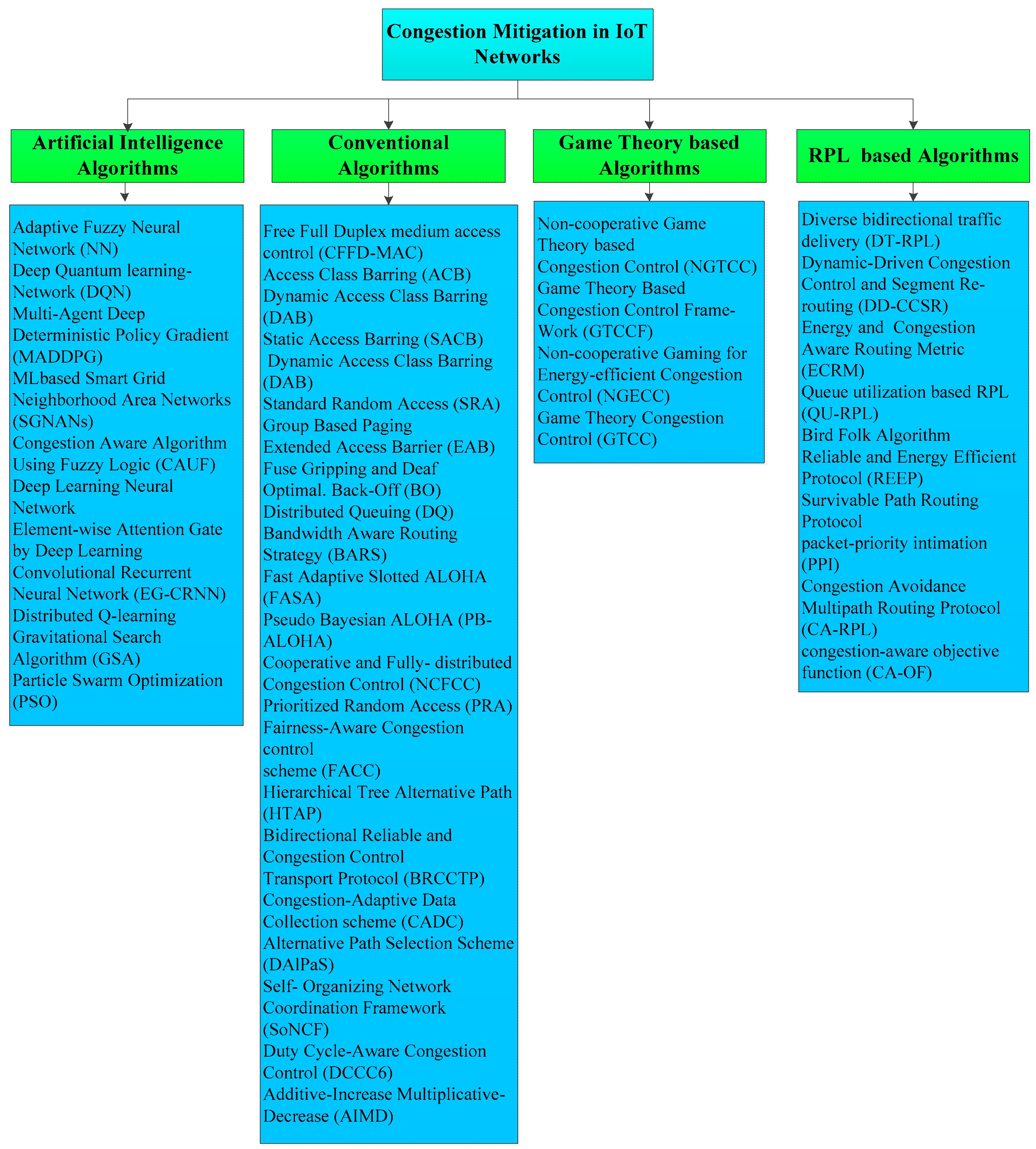
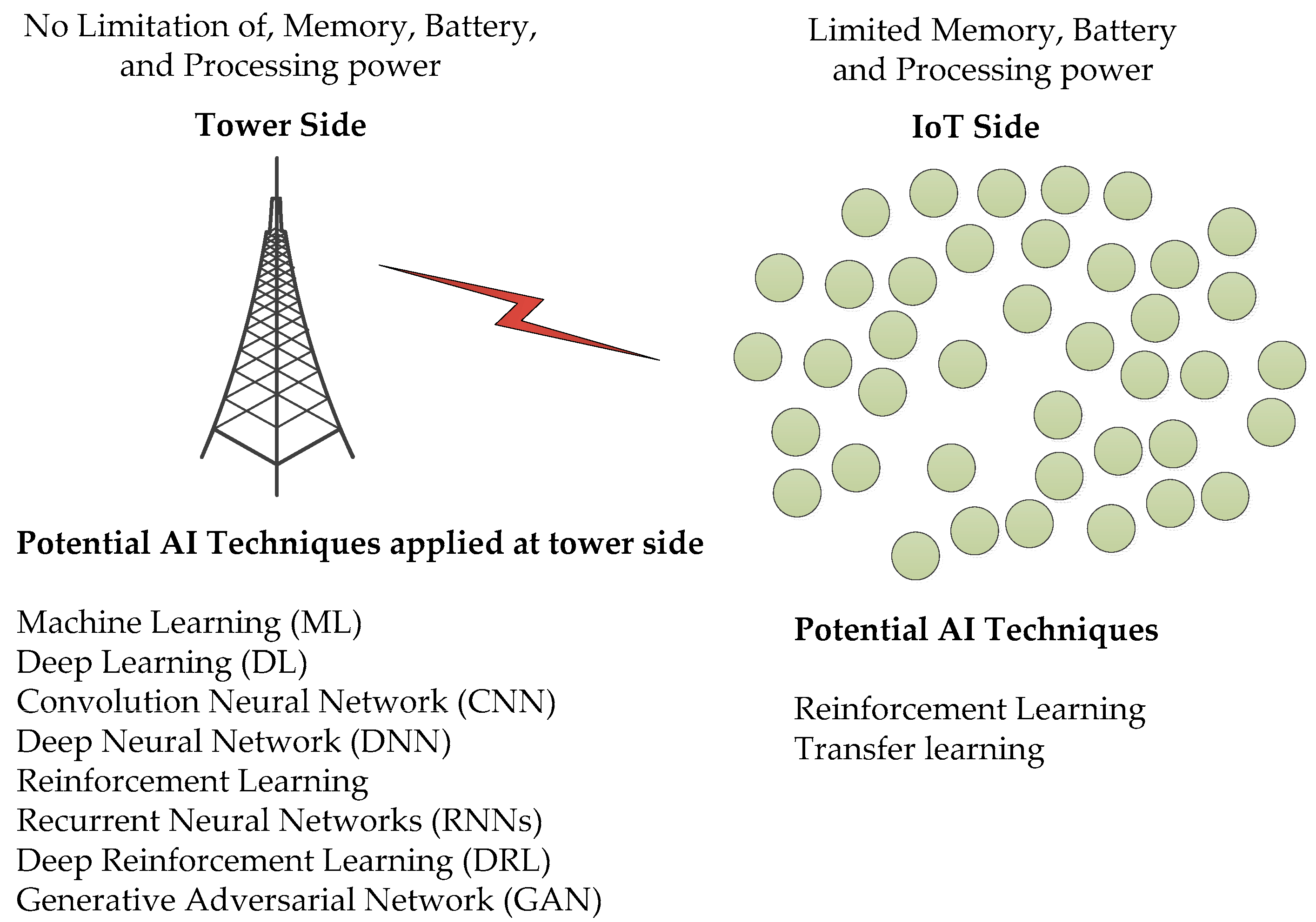
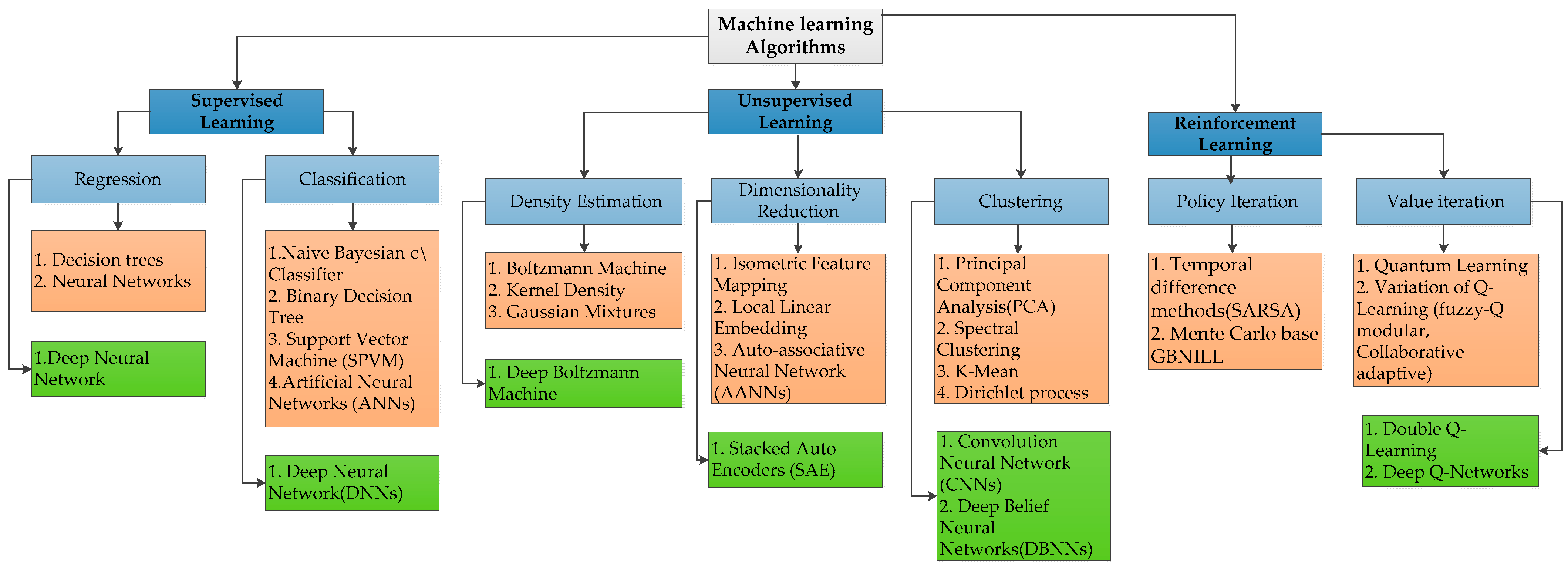
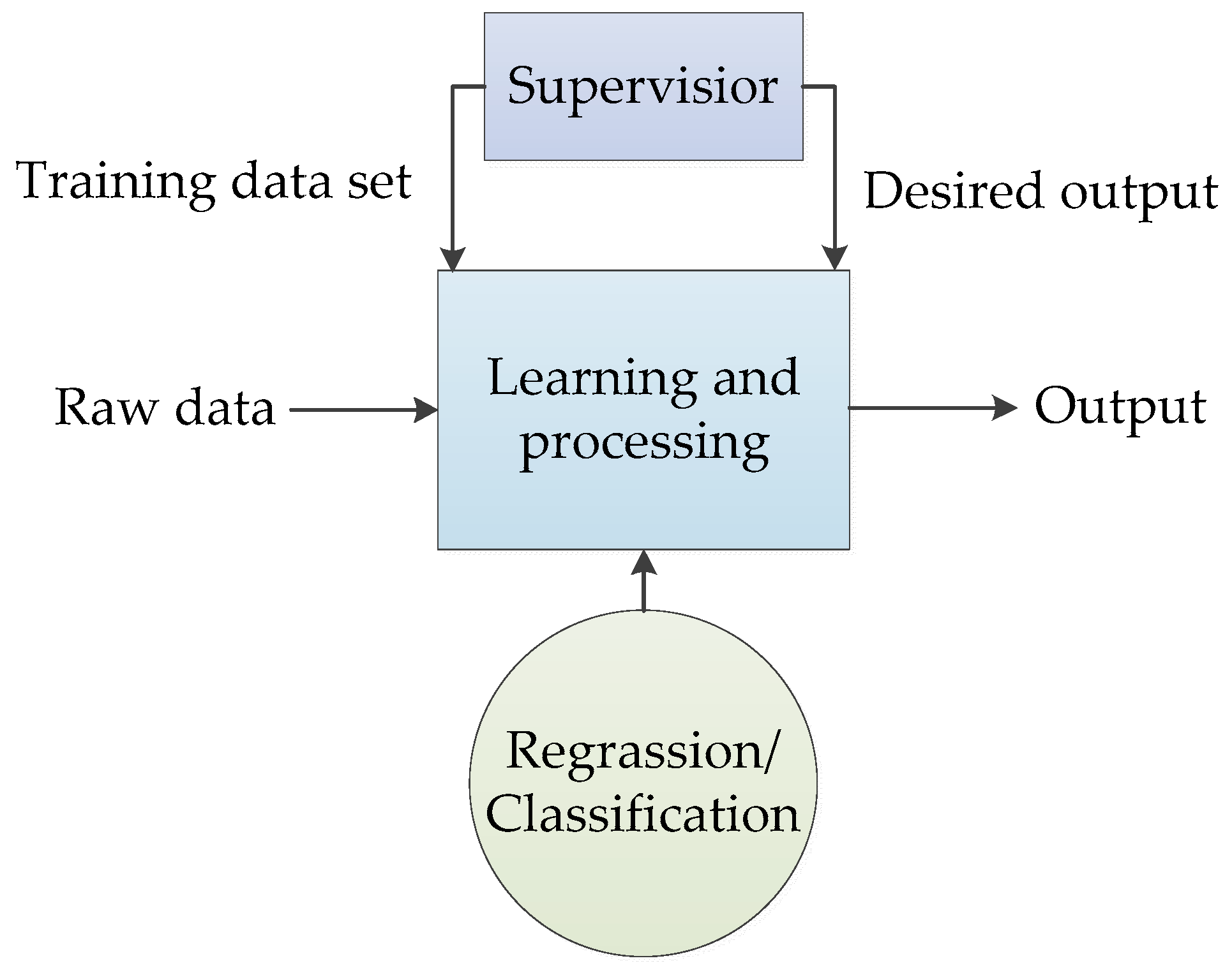
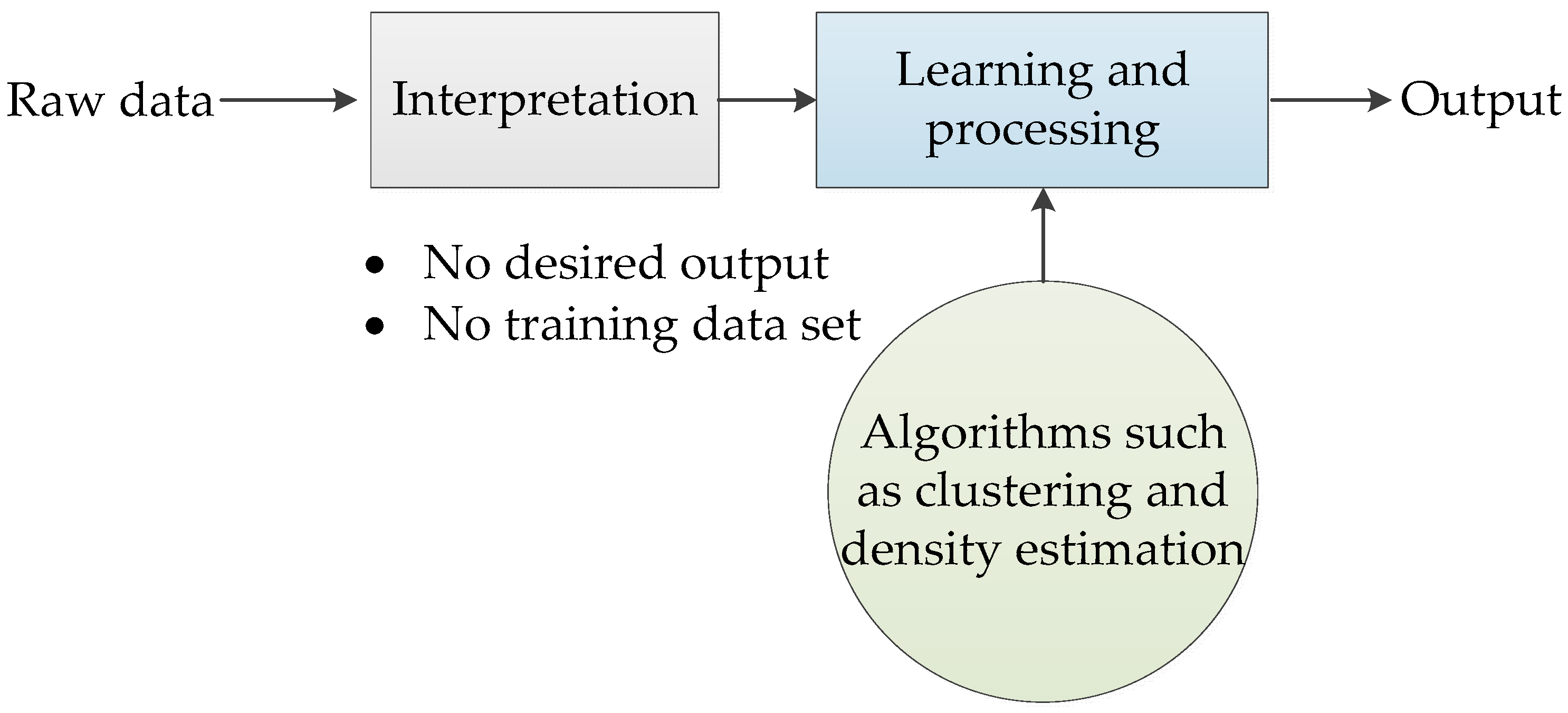
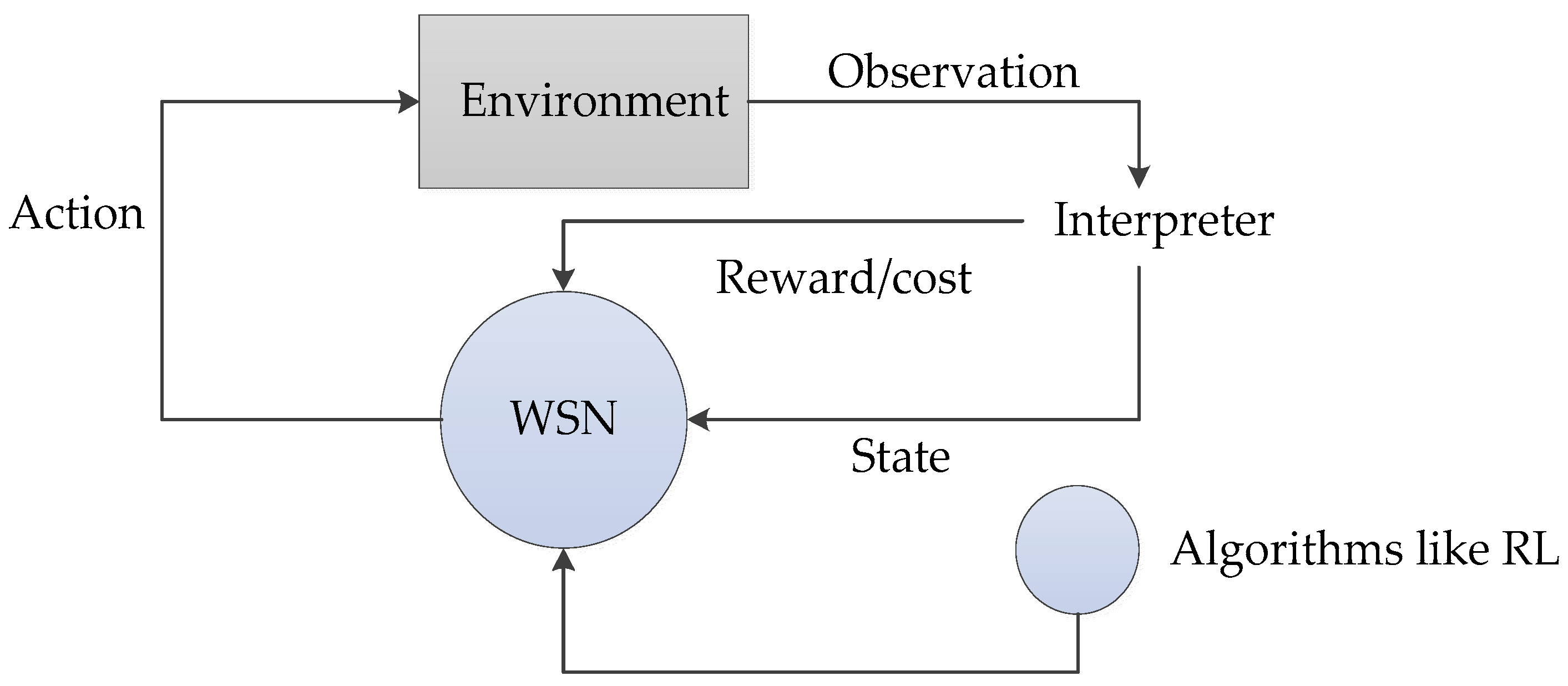
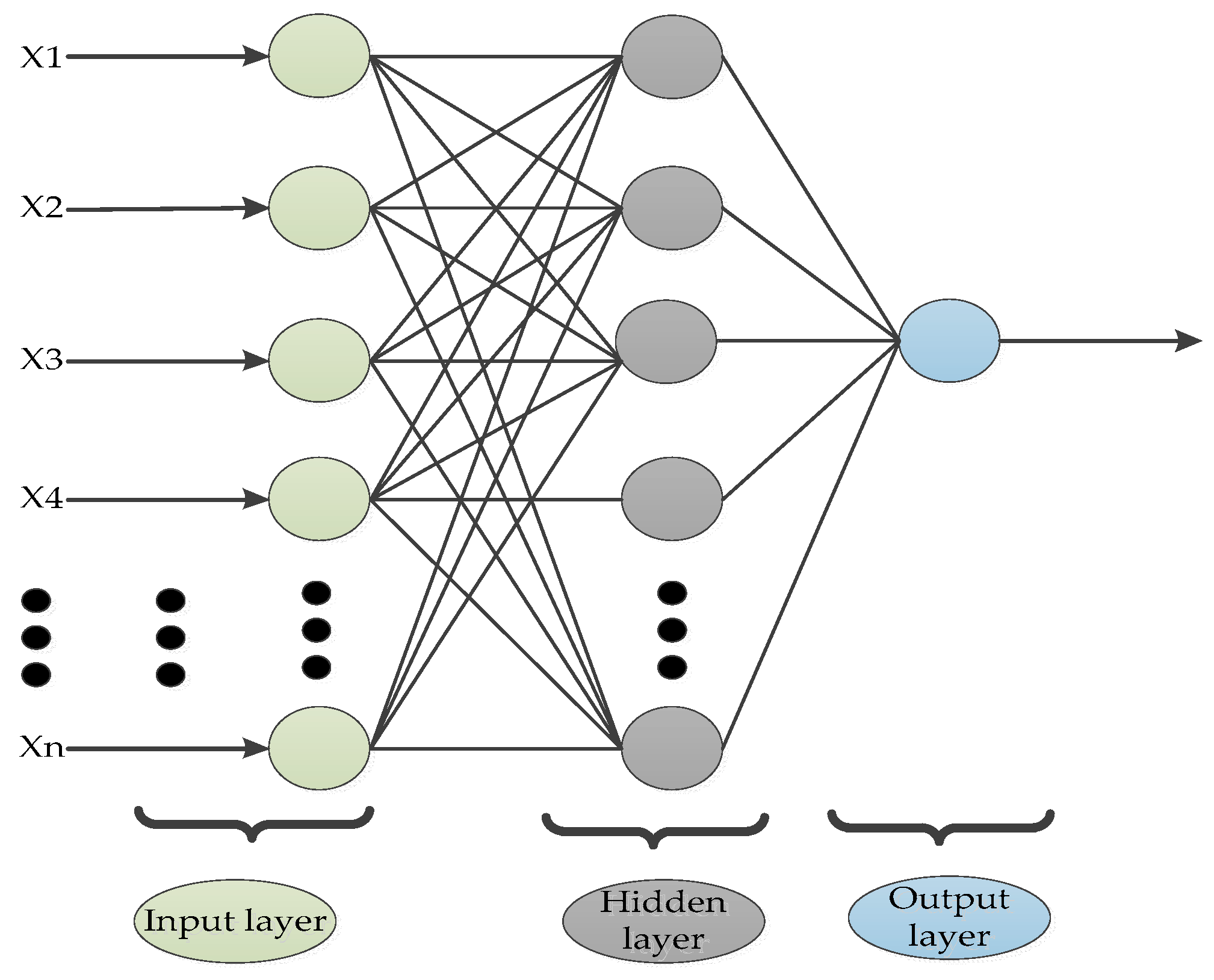
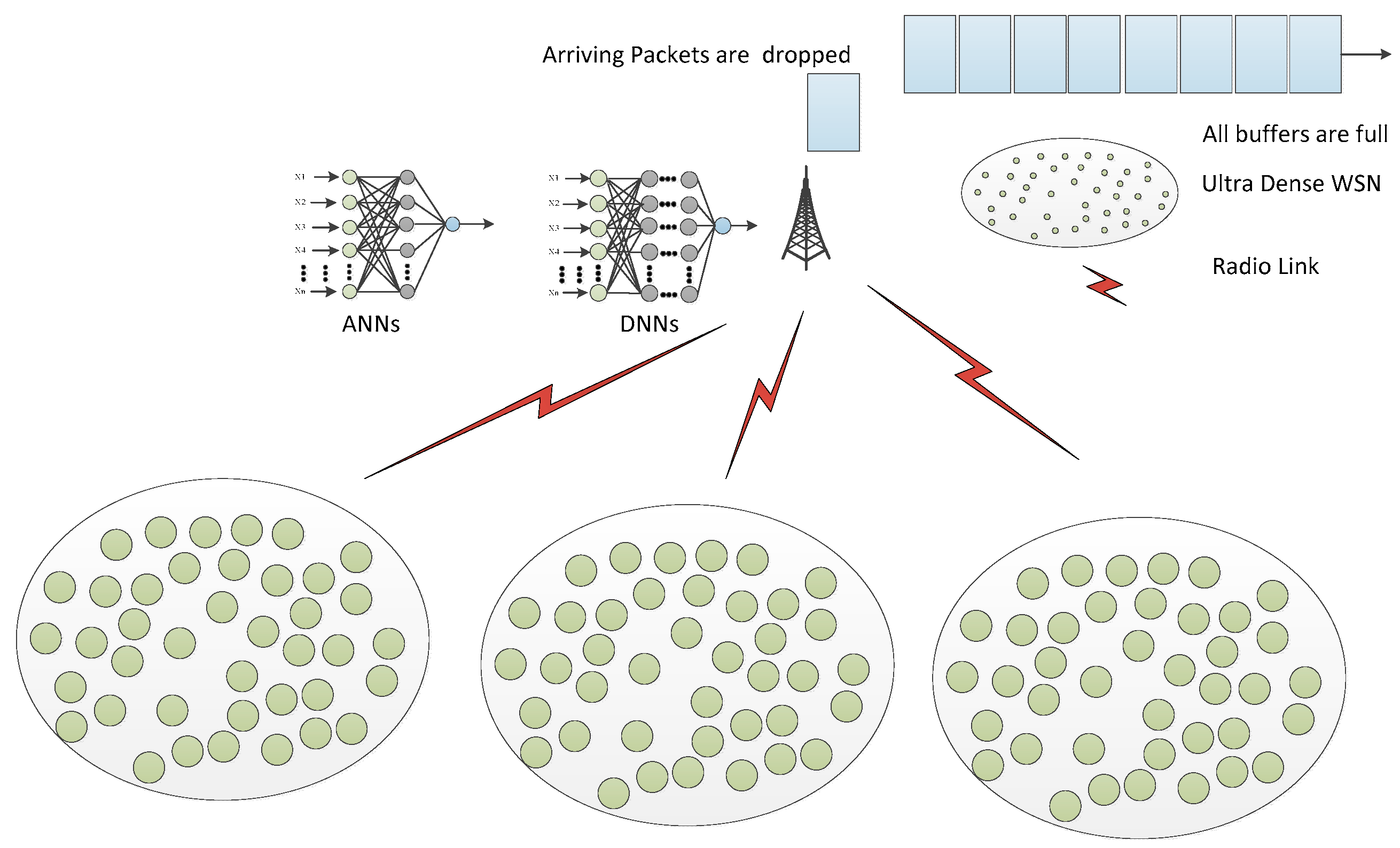
| Acronyms | Definition |
|---|---|
| IOT | Internet of Things |
| IP | Internet Protocol |
| 6LoWPAN | IPv6 over Low-Power Wireless Personal Area Network |
| QoS | Quality of Service |
| I-IOT | Intelligent Internet of Things |
| RACH | Random Access Channel |
| ROC | Receiver Operating characteristic |
| SGNANs | Smart Grid Neighborhood Area Networks |
| SoNCF | Self-organizing network coordination framework |
| TCP/IP | Transmission Control Protocol IP |
| TARA | Topology Aware Resource Adaptation (TARA) |
| LTE-A | Long-Term Evolution-Advanced |
| LSTM | Long Short-Term Memory |
| ML | Machine Learning |
| M2M | Machine to Machine |
| MAC | Media Access Control |
| CAT-M | Machine type category |
| mMTC | Massive Machine Type Communication |
| MADM | Multi-Attribute Decision Making |
| CAT-N | Narrowband IoT Category |
| OS | Operating system |
| OHCA | Optimization-based Hybrid Congestion Alleviation |
| PB-ALOHA | Pseudo Bayesian ALOHA |
| PRA | Prioritized Random Access |
| PSO | Particle Swarm Optimization |
| RPL | Routing Protocol low-power and lossy networks |
| SOSUS | Sound Surveillance System |
| SDN-IoT | Software-Defined Networking based on IoT |
| SDRs | Software-Defined Routers |
| TR | Technical Report |
| UDP | User Datagram Protocol |
| USA | United States of America |
| WSNs | Wireless Sensor Networks |
| Main Domain | Ref | Type | Year | Contribution | Scope of the Work | ||
|---|---|---|---|---|---|---|---|
| Congestion | IoT | AI | |||||
| Game theory application security prospect | [23] | Survey | 2008 | Survey on Game theory to solve challenges relevant to energy efficiency and security | X | ✓ | ✓ |
| Role of LTE-A in Emerging Machine Type Category (CAT-M) and Narrowband IoT Category (CAT-N). | [24] | Survey | 2017 | Up-to-date and comprehensive survey on (CAT-M) and (CAT-N). | ✓ | ✓ | X |
| Machine learning applications in the IoT domain | [25] | Survey | 2018 | Comprehensive Survey on ML techniques and applications in IoT | X | ✓ | ✓ |
| Routing Protocol low-power and lossy networks (RPL) by contiki operating system (OS) | [26] | Survey | 2018 | First Survey that categories RPL via contiki OS | ✓ | ✓ | X |
| Deep Transfer Learning | [27] | Survey | 2018 | Review latest work on transfer learning via DNNs as well as their application. | X | X | ✓ |
| Application Deep reinforcement learning (DRL) in IoT and UAV | [27] | Survey | 2019 | Review on Deep reinforcement learning in network different prospects. | X | ✓ | ✓ |
| WSN recourses allocation by DL and ML. | [28] | Survey | 2020 | This work comprehends the DL and ML based techniques for resource allocation in WSN in Heterogeneous Networks (HetNets), NOMA, D2D communication prospective. | X | ✓ | ✓ |
| Various congestion mitigation algorithms are reviewed. | [29] | Survey | 2020 | This review is based on different techniques to control congestion as well a novel taxonomy has been proposed. | ✓ | X | ✓ |
| Transfer Learning | [30] | Survey | 2021 | Transfer learning and different machine learning techniques relationships. | X | ✓ | X |
| Congestion mitigation AI algorithms in nature | [24] | Survey | 2023 | Reviewed AI algorithms exist in nature. | ✓ | X | ✓ |
| AI based algorithms review to solve congestion in WSN. | This work | Survey | 2023 | The novel review on congestion mitigation based on AI based solution in WSN. | ✓ | ✓ | ✓ |
| Reference | RPL | Smart Grid | 6LowPAN | Game Theory | WSN | Health Care IoT | Industrial IoT | AI | I-IoT | Optimization |
|---|---|---|---|---|---|---|---|---|---|---|
| [38,39] | ✓ | X | ✓ | ✓ | X | X | X | X | X | |
| [40] | X | ✓ | X | ✓ | X | X | X | X | X | |
| [41,42] | X | ✓ | ✓ | ✓ | X | X | X | X | X | |
| [43,44] | ✓ | ✓ | ✓ | |||||||
| [44,45,46,47] | ✓ | X | X | X | ✓ | X | X | X | X | X |
| [48] | X | X | X | X | X | X | ✓ | ✓ | ||
| [49] | ✓ | X | X | X | ✓ | X | ✓ | X | X | |
| [50] | X | X | X | ✓ | ✓ | X | ||||
| [51] | X | X | X | X | ✓ | X | ✓ | ✓ | ✓ | |
| [52] | X | X | X | X | ✓ | ✓ | ✓ | |||
| This work | ✓ | ✓ | ✓ | ✓ | ✓ | ✓ | ✓ | ✓ | ✓ | ✓ |
| Algo. | Ref. | Solution Technique | Packet Loss Type | Limitation | ||||
|---|---|---|---|---|---|---|---|---|
| Traffic Control | Resource Control | 6LoWPAN | WSN | Buffer Loss | Channel Loss | |||
| Back pressure | [67] | ✓ | X | ✓ | X | ✓ | X | Simulation not verified in real WSN simulators like cooja |
| GTCCF | [38] | ✓ | X | ✓ | X | ✓ | X | High energy consumption, low throughput |
| OHCA | [66] | ✓ | ✓ | ✓ | X | ✓ | X | High energy consumption, low throughput |
| NCGEE | [77] | ✓ | ✓ | ✓ | X | ✓ | ✓ | - |
| Game Theory | [23,75] | ✓ | X | ✓ | X | ✓ | X | - |
| DCCC6 | [89] | X | ✓ | ✓ | X | ✓ | X | - |
| GTCC | [41], | ✓ | X | ✓ | X | ✓ | X | - |
| RPL | [39] | ✓ | X | ✓ | X | ✓ | X | - |
| This work | - | ✓ | ✓ | ✓ | ✓ | ✓ | ✓ | - |
| Learning Algo | Advantages | Disadvantages | Application in IoT |
|---|---|---|---|
| Supervised Learning | (a) Fully integrated control of data analysis. (b) Output of the model is in advance known. (c) Suited to learning challenges with labeled input data. | (a) Labeled data are required (b) Data sets for training needed in large numbers. (c) High capacity for computation is required. | (a) Learning based on an instance, reasoning based on the case, Bayesian networks, support vector machines, ANNs, K-nearest neighbor, decision Trees, case-based reasoning, and ensembles of classifiers [91]. (b) In constrained resources environments and distributed environments such as IoE face difficulties in implementing Supervised Learning. |
| Unsupervised Learning | (a) labeled data not needed (b) In unlabeled data attempts to sort hidden structure. (c) Human error is minimized arises in Supervised Learning) (d) Feasible for complex and large models where labeled is not available. | (a) Only the data sets at input are needed and no previous information about data sets as well as output is required. (b) The objectives of learning are subjective compared with the Supervised Learning (c) No much control of data analysts over data. | (a) The major application of Unsupervised learning in the prospect includes ANNs, clustering, and association rule learning [99]. (b) This learning scheme is utilized in the application of IoE that requires hidden layer extraction, and faster results in the ultra-dense IoE networks. |
| Reinforcement Learning | (a) No labeled data set as well as the desired output (b) Computational complexity is less in comparison to Supervised Learning and Unsupervised learning. (c) Easily implemented in a distributed framework like IoT. (d) Trade-off between exploitation and exploration. (e) Suitable for real-time environment learning | (a) No previous information about the environment is needed. (b) Take more time for steady-state convergence. (c) The learning depends on the agent’s actions, and observations. (d) Learning depends on the reward and plenty. Learning may be affected when the distribution of plenty and reward in a distributed environment. | (a) Distributed implementation and operation simplicity make it a favorite for IoE environments. (b) The dynamic wireless IoE environment is feasible for continuous, interaction with the environment, continuous learning and reward actionable feedback with the environment. (c) The RL’s main application in IoE is Q-learning. |
| Deep Learning | (a) Reduce the feature extraction part that wastes time used in classical ML. (b) Highly flexible and configurable than the classical ML. (c) May achieve learning accuracies higher than the classical ML (d) When the data amount is large performance is much better in compassion with the classical ML. | (a) Involvement of many parameters and slower learning process. (b) Sensitive to the size of data and data structure. (c) The topology determination, parameter, and the topology training method lacking theoretical tools. (d) DL algorithms require more time and a high GPU framework. (e) It is more difficult to interpret the DL models. | (a) In the existing literature DL algorithms applications include LSTM, deep Recurrent Neural Networks (RNNs), deep belief networks, CNNs networks, and Boltzmann machine [97]. (b) Easy to extract the accurate information, accurate information from the complex as well as the raw WSNs data system. (c) The need for huge battery, memory, and energy resources it challenging to deploy the DL in distributed devices with constraint recourses devices [100]. |
Disclaimer/Publisher’s Note: The statements, opinions and data contained in all publications are solely those of the individual author(s) and contributor(s) and not of MDPI and/or the editor(s). MDPI and/or the editor(s) disclaim responsibility for any injury to people or property resulting from any ideas, methods, instructions or products referred to in the content. |
© 2023 by the authors. Licensee MDPI, Basel, Switzerland. This article is an open access article distributed under the terms and conditions of the Creative Commons Attribution (CC BY) license (https://creativecommons.org/licenses/by/4.0/).
Share and Cite
Umar, A.; Khalid, Z.; Ali, M.; Abazeed, M.; Alqahtani, A.; Ullah, R.; Safdar, H. A Review on Congestion Mitigation Techniques in Ultra-Dense Wireless Sensor Networks: State-of-the-Art Future Emerging Artificial Intelligence-Based Solutions. Appl. Sci. 2023, 13, 12384. https://doi.org/10.3390/app132212384
Umar A, Khalid Z, Ali M, Abazeed M, Alqahtani A, Ullah R, Safdar H. A Review on Congestion Mitigation Techniques in Ultra-Dense Wireless Sensor Networks: State-of-the-Art Future Emerging Artificial Intelligence-Based Solutions. Applied Sciences. 2023; 13(22):12384. https://doi.org/10.3390/app132212384
Chicago/Turabian StyleUmar, Abdullah, Zubair Khalid, Mohammed Ali, Mohammed Abazeed, Ali Alqahtani, Rahat Ullah, and Hashim Safdar. 2023. "A Review on Congestion Mitigation Techniques in Ultra-Dense Wireless Sensor Networks: State-of-the-Art Future Emerging Artificial Intelligence-Based Solutions" Applied Sciences 13, no. 22: 12384. https://doi.org/10.3390/app132212384
APA StyleUmar, A., Khalid, Z., Ali, M., Abazeed, M., Alqahtani, A., Ullah, R., & Safdar, H. (2023). A Review on Congestion Mitigation Techniques in Ultra-Dense Wireless Sensor Networks: State-of-the-Art Future Emerging Artificial Intelligence-Based Solutions. Applied Sciences, 13(22), 12384. https://doi.org/10.3390/app132212384






